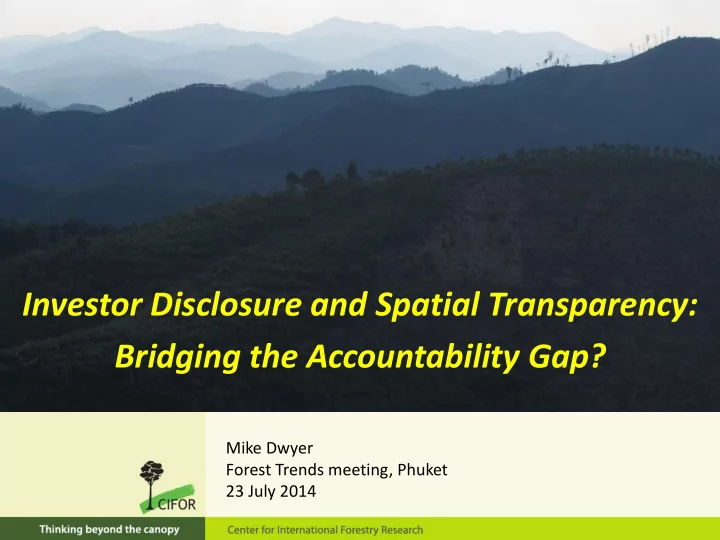

Investor Disclosure and Spatial Transparency: Bridging the Accountability Gap? Mike Dwyer Forest Trends meeting, Phuket 23 July 2014
Who is (or was or will be) doing what, where? And how do we know? Specifically, is it possible to cross reference concession inventory systems (as reported online) What should be the public’s role in this process? with shareholder reports (as provided in publicly available databases)
SPATIAL TRANSPARENCY DISCLOSURE TO INVESTORS What data do governments give What data do companies give their the public about who is investing investors about where and how in what, where? they are spending their money? Specifically, is it possible to cross reference concession inventory systems (as reported online) with shareholder reports (as provided in publicly available databases)
SPATIAL TRANSPARENCY DISCLOSURE TO INVESTORS What data do governments give What data do companies give their the public about who is investing investors about where and how in what, where? they are spending their money? • • Public companies’ annual Online spatial databases • Other online data with reports • spatial reference Financial databases (e.g., Bloomberg, ThomsonOne) information Is it possible to cross reference concession inventory systems (as reported online) Specifically, is it possible to cross reference concession inventory systems (as reported online) with companies annual reports? with shareholder reports (as provided in publicly available databases)
Data Managed by Approx. & not to Chinese gov. Government of scale spending on China: XSB opium poppy Prefecture replacement Commerce agribusiness in Department Myanmar & Laos State land lease & Government of concession Laos: National locations* Statistics inventoried 2007- Department 2011 by NLMA/ MONRE with GIZ support Economic land Civil Society : concession Open locations** (from Development MAFF or Royal Cambodia (ODC) Gazette) Oil palm Civil society : concessions from World Resources Ministry of Institute (WRI) Forestry
Agricultural and tree plantation concessions Savannakhet Economic Land Concessions (ELCs) Salavan Xekong Kon Attapeu Champasak Tum Preah Vihear Gia Lai Stung Ratanakiri Treng Dac Kampong Thom Lac Mondolkiri Kratie Dac Nong Binh Phuoc Based on data from Decide-Info Laos (http://decide.la) and OpenDevelopmentCambodia.net
Oil palm concessions (n=1,220) Cross-reference? Yes n=12 Yes if GAR data n=17 No Based on data from WRI Forest Cover Analyzer (now Global Forest Watch)
GAR plantations (2012) Oil palm concessions (n=1,220) Cross-reference? Yes n=12 Yes if GAR data n=17 No Based on data from WRI Forest Cover Analyzer (now Global Forest Watch)
Based on data available at http://xsbn.mofcom.gov.cn/aarticle/gonggao/200809/20080905777443.html
Conclusions Investment/development is outpacing regulation: old data, partial data, subsidiaries. Information systems thus tend to reflect opaque systems of governance more than they offer transparency, whether materially or legally.
Conclusions Investment/development is outpacing regulation: old data, partial data, subsidiaries. Information systems thus tend to reflect opaque systems of governance more than they offer transparency, whether materially or legally. Information systems nonetheless offer significant forms of partial transparency, and thus represent an important area of engagement/struggle over the public’s role in development.
Conclusions Investment/development is outpacing regulation: old data, partial data, subsidiaries. Information systems thus tend to reflect opaque systems of governance more than they offer transparency, whether materially or legally. Information systems nonetheless offer significant forms of partial transparency, and thus represent an important area of engagement/struggle over the public’s role in development. Three concrete proposals • Clarify public’s legal right to know about who, what, where, when. • Gazetting of public resource concessions? • Greater spatial disclosure to investors?
Recommend
More recommend